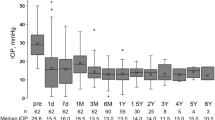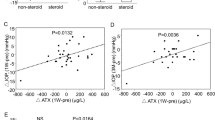Abstract
Graft survival has been evaluated for patients who underwent subsequent intraocular surgery (extra-capsular cataract surgery or trabeculectomy) between 1983 and 1989. The patients were different from the majority of keratoplasty patients as evidenced by the indications for keratoplasty; corneal perforation was the indication in 24% of cases. Perforated and inflamed eyes were treated aggressively at the time of the acute event, including emergency keratoplasty and intensive topical steroids. Visco-elastic fluids were routinely used during secondary surgery and topical steroids were administered intensively post-operatively. The incidence of post-operative graft rejection was low (less than 14%). Rejection episodes were diagnosed early, prior to the appearance of a Khodadoust line, and were treated aggressively with intensive topical steroids. Glaucoma which was not controlled by topical therapy was surgically managed by trabeculectomy in the first instance. If this failed, tube drainage was performed and long-term topical steroids were administered. The only risk factor identified was uncontrolled glaucoma, P=0.1. The probability of graft survival (at five years) was 0.83 after cataract surgery and 0.62 after trabecuectomy, but wide confidence limits indicate the difference is not significant.
Similar content being viewed by others
Log in or create a free account to read this content
Gain free access to this article, as well as selected content from this journal and more on nature.com
or
References
Abbott RL and Forster RK : Clinical specular microscopy and intraocular surgery. Arch Ophthalmol 1979, 97: 1476–9.
Gilvarry AME, Kirkness CM, Steele AD, et al.: The management of post-keratoplasty glaucoma by trabeculectomy. Eye 1989, 3: 713–18.
Schockett SS, Nirankari VS, Lakhanpal V, et al.: Anterior chamber tube shunt to an encircling band in the treatment of neovascular glaucoma and other refractory glaucomas. Ophthalmology 1985, 92: 553–62.
Coster DJ : Mechanisms of corneal graft failure: the erosion of corneal privilege. Eye 1989, 3: 251–62.
Kirkness CM, Ling Y, Rice NSC : The use of silicone drainage tubing to control post-keratoplasty glaucoma. Eye 1988, 2: 583–90.
Kaplan E and Meier P : Non-parametric estimation from incomplete observations. J Am Statis Ass 1958, 53: 457–81.
Crawford GJ, Stulting RD, Waring GO : The triple procedure. Analysis of outcome, refraction and intraocular lens power calculation. Ophthalmology 1986, 93: 817–24.
Kirkness CM, Cheong PY, Steele AD : Penetrating keratoplasty and cataract surgery: the advantages of an extracapsular technique combined with posterior chamber intraocular implantation. Eye 1987, 1: 557–61.
Insler MS, Cooper HD, Kastl PR, et al..: Penetrating keratoplasty with trabeculectomy. Am J Ophthalmol 1985, 100: 593–5.
Foulks GN : Glaucoma associated with penetrating keratoplasty. Ophthalmology 1987, 94: 871–4.
Ficker LA, Kirkness CM, Rice NSC, et al.: The changing management and improved prognosis for corneal grafting in Herpes simplex keratitis. Ophthalmology 1989, 96: 1587–96.
Author information
Authors and Affiliations
Rights and permissions
About this article
Cite this article
Ficker, L., Kirkness, C., Steele, A. et al. Intraocular surgery following penetrating keratoplasty: The risks and advantages. Eye 4, 693–697 (1990). https://doi.org/10.1038/eye.1990.97
Issue date:
DOI: https://doi.org/10.1038/eye.1990.97
This article is cited by
-
Outcomes of Ahmed glaucoma valve implantation and risk factors for graft failure in eyes with Descemet’s stripping endothelial keratoplasty
International Ophthalmology (2022)
-
The visual and refractive outcomes of combined and sequential penetrating keratoplasty, cataract extraction, and intraocular lens insertion
Eye (2009)
-
Graft failure: III. Glaucoma escalation after penetrating keratoplasty
International Ophthalmology (2008)
-
Refractive results after corneal triple procedures (PK+ECCE+IOL)
Eye (1993)



